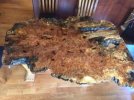- Joined
- Jun 3, 2019
- Messages
- 2,714
Randy - what you just described is a solar kiln ... the purpose is to speed up the drying without cracking. It is basically ... wrapping the wood in plastic and putting it in the sun. You guys get pissed at me when i talk science and mechanisms ... so i will just leave it at that for now.I noticed another fellow that sells slabs close to me has made a booth out of a wood frame and plastic....a bit like a greenhouse but only about 5 feet tall. He had a fan at one end and small opening at either end in the plastic. I assumed it was an effective way of drying faster, but I never talked to him about it. The guy sells hundreds of slabs a year so I'm sure he knows what he is doing.
i would not recommend trying anything different on some really nice piece of wood ... but if i were to have a piece i would not cry over, i would likely try it. If it fails ... well, my neighbor has a nice fire pit in the back yard...

 (although I would have changed this to read, "... especially if you try to stabilize scales...")
(although I would have changed this to read, "... especially if you try to stabilize scales...")